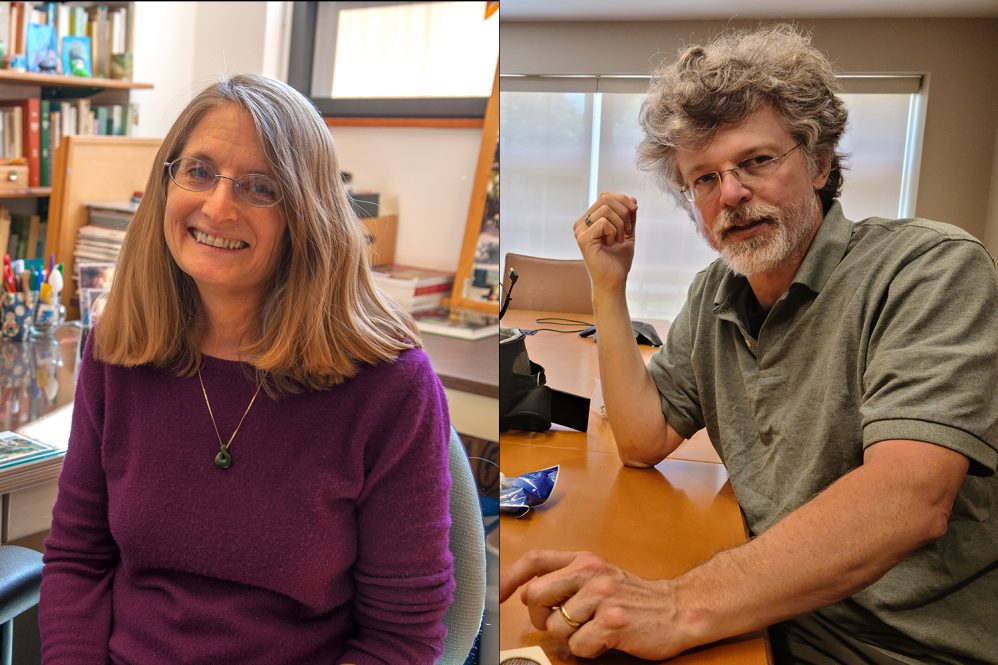This is a story about Christine Simon and John Cooley.
It is not a story about cicadas – although it is tough to separate the two UConn professors from the insects, which just recently took over the headlines as a massive group of them, known as Brood X, made their way above ground in a vast area of the United States from the Mid-Atlantic region to the Midwest.
This brood appears as adults only once every 17 years and are now headed back to the earth, and the country will move to other fascinations.
Meanwhile, Simon and Cooley will keep studying them – and talking about them for all who are interested.
A quick search of the headlines from the last few months will produce the usual news topics – and cicadas. And more often than not, Simon and Cooley were quoted as experts as they helped further UConn’s reputation around the country, and the world.
Whether it was traditional media, like The Washington Post, ABC News, or Country Living magazine, or outlets that are less familiar to a general audience, like EcoWatch or Science Daily, Simon and Cooley’s names were trending alongside the likes of celebrities and athletes.
“I think one of the big reasons that the cicada story was so popular this time around was that it had nothing to do with politics or COVID,” says Simon, who is a professor in the Department of Ecology and Evolutionary Biology and also directs her own lab. “Everyone’s been listening to COVID and political stories for more than a year, and they are tired of them. Cicadas are something different that people can talk about and laugh about. It’s not political and it’s a story that everybody has some interest in.”
The two also believe the cicadas were a big news story because of the major metropolitan areas that the insect made an appearance in, like Washington, D.C., Baltimore, and Cincinnati.
“I have resisted throughout my career being known as the cicada guy; whether I have been successful, that is another question,” says Cooley, who is an assistant professor in residence in the Department of Ecology and Evolutionary Biology. “I’m a guy that tries to ask big questions, and get answers by using cicadas.”
Cooley originally came to UConn to work for Simon as a post-doctoral fellow, and the two have been researching cicadas ever since. They even developed a website that allowed people to track where the cicadas were making their latest appearance.
Both Simon and Cooley developed their interest in nature as a young age. As their knowledge grew and they continued their education, cicadas became a perfect way to study species and speciation.
“Ever since I was a little kid, I liked playing in the woods, collecting animals and planting things,” says Simon, who grew up in Memphis, before moving to Florida and Long Island.
“When I was in graduate school, I wanted to work on speciation and what is a species, and one of the organisms I did research on was periodical cicadas, because I knew I needed to find something that was in the process of forming new species. I knew about the year classes of broods and that they were reproductive isolated.”
For the two UConn professors, the cicadas have played a huge role in their lives. But, why should a non-scientist have an interest in them?
“They are a big part of nature, and they fit into the ecosystem,” says Simon. “When you remove one part of the ecosystem, maybe everything will be fine. But we keep removing little pieces, and eventually the whole thing will collapse like one of those games where you pull out the sticks and try not to have the tower collapse.”
Cooley, who grew up in the Chicago area, sees public interest in cicadas as having an impact that far exceeds their appearance this summer.
“As citizens, we are asked to make decisions about who we vote for and what policies we support,” says Cooley. “Ultimately, these decisions will affect our well-being in the future. There’s a big discussion right now in this country and other countries about global change. Many of the decisions you make at the ballot box will affect how we respond to or how we counteract the problems of global change. An educated citizenry about things like cicadas is going to be able to make more intelligent, reasonable decisions.”
They both spent time in the field where the cicadas were appearing. Now that this brood of cicadas has moved back underground, Simon and Cooley will remain busy in their research and teaching. Cooley teaches biology classes at the UConn Hartford campus.
“Our regional campus students tend to be more urban and suburban than our Storrs students,” says Cooley. “We try new things there to get people to learn more about nature. A lot of them have never really been outside to learn how nature works.”
Cooley also stays busy with carpentry work and hiking with his family. Simon enjoys gardening, cooking, hiking and travel. She also loves photography and made it a point to take pictures outside every day during the pandemic.
But while both scholars have richly developed lives and interests beyond the topic of cicadas, the inescapable question remains: when we will all be gripped with cicada-mania again?
“Cicadas come out almost every year somewhere in the United States,” says Cooley. “Turns out the new two-years are an exception, so we won’t be hearing anything about them in 2022 or 2023. But, in 2024, both 13- and 17-year cicadas will be coming out. It’s going to be everywhere from Maryland to the Oklahoma boarder and all the way over to Illinois. It’s going to be huge, like the Super Bowl of cicadas.”



